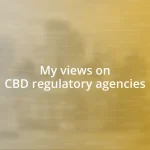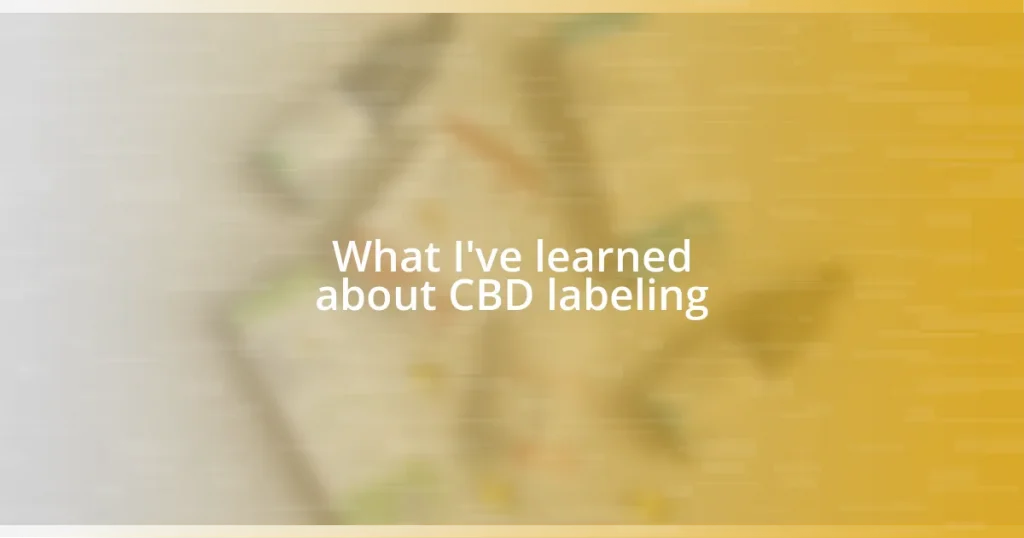Key takeaways:
- Understanding the differences between full-spectrum and broad-spectrum CBD is crucial for product selection and effects.
- Accurate labeling, including CBD concentration and third-party testing, is essential for consumer trust and informed choices.
- Common mistakes include vague language on CBD type and unclear serving sizes, which can lead to ineffective dosing.
- Regulatory variability affects labeling practices; consumers should seek transparency and verify claims with lab results.

Understanding CBD labeling basics
When I first started exploring CBD products, I was struck by how confusing labeling can be. For instance, some products prominently display “full-spectrum” or “broad-spectrum” but don’t explain what that really means. Knowing the difference can be crucial—full-spectrum means it contains a range of cannabinoids, while broad-spectrum is similar but without THC. Isn’t it a bit overwhelming to think you’re expected to decipher all this jargon?
I remember picking up a CBD tincture that seemed perfect based on the label—until I noticed the serving size and realized I would need to take a whole dropper just to hit the recommended dose. I learned that reading the dosage instructions carefully is essential because it’s easy to underestimate how much you actually need. Ever thought about how a tiny mistake in dosage can affect your experience?
It’s also important to check for third-party lab results on the label. This information gives you insights into the product’s purity and potency. I once overlooked this detail and ended up with a product that didn’t match its claims. If each label features access to testing results, wouldn’t that empower consumers to make better choices? Understanding these basics can truly transform your CBD journey.

Importance of accurate CBD labels
Accurate CBD labeling is crucial because it ensures consumers know exactly what they’re getting. I’ve seen too many friends excitedly trying a new product only to be disappointed when it didn’t deliver the benefits they anticipated. The label should reflect the actual content, and without that accuracy, it can lead to confusion and mistrust in this growing market. When we’re investing in our health, we deserve transparency.
Key aspects of accurate CBD labels include:
- CBD concentration: Knowing the exact amount per serving helps guide effective dosing.
- Third-party testing: Lab results validate the contents and purity, building trust in the product.
- Type of CBD: To tie back to my earlier experiences, understanding whether it’s full-spectrum, broad-spectrum, or isolate can greatly influence effects and legality.
- Source of hemp: The origin can affect quality, as some regions have better farming practices than others.
- Additives or ingredients: Being aware of potential allergens or unnecessary fillers is vital for informed choices.
I remember the frustration of grabbing a seemingly fantastic product, only to realize later that the expected effects were simply absent. It was a reminder of how misleading labels can undermine consumer confidence. There’s something profoundly unsettling about trusting a product that doesn’t meet its claims, and that’s why accuracy in labeling isn’t just beneficial; it’s essential.

Key components of CBD labels
When examining CBD labels, you’ll often notice crucial components that genuinely matter. One of the key pieces of information is the serving size, which can vary significantly from product to product. I learned this the hard way when I purchased a CBD gummy that seemed ideal until I realized each serving contained only a fraction of the actual dose I needed. It left me feeling frustrated and underwhelmed, reminding me to always pay close attention to that detail.
Another vital inclusion is the CBD concentration, typically expressed in milligrams (mg). It’s essential to understand how much CBD you’re getting with each serving. I remember trying a new oil and being shocked at how low the concentration was compared to what I was accustomed to. It turned out that it took much longer for me to feel any effects, reinforcing the importance of knowing the potency upfront if you want to tailor your experience effectively.
| Key Label Component | Importance |
|---|---|
| CBD Concentration | Indicates how much CBD is in each serving, guiding effective dosing. |
| Type of CBD | Informs whether it’s full-spectrum, broad-spectrum, or isolate; impacts effects. |
| Third-Party Testing | Provides verification of product purity and potency, building consumer trust. |
| Source of Hemp | Reflects the quality of the raw materials used and ethical farming practices. |
| Additives/Ingredients | Highlights potential allergens or unnecessary fillers, ensuring informed choices. |

Common labeling mistakes to avoid
One common labeling mistake I’ve come across is the omission of crucial information, such as the total CBD amount versus the amount per serving. The first time I saw a label that only listed the per-serving content, it left me puzzled. I remember thinking, “How on earth do I know how many servings are in this bottle?” Without clear serving sizes, you risk overdosing or not getting enough to feel the effects. It’s a simple detail that can make a world of difference.
Another frequent issue is using vague language about the type of CBD. I once picked up a product labeled as “hemp extract” without any clarity on whether it was full-spectrum or isolate. That experience taught me just how significant those terms can be. What if I had been looking for the entourage effect provided by other cannabinoids? It’s essential to ensure the label clearly describes the extract type to empower buyers in making informed choices.
Lastly, I’ve noticed brands that fail to mention sourcing details. The first time I tried a CBD product from a less-known hemp source, the effects were minimal compared to my go-to brand. It made me wonder whether the quality varied significantly based on the growing practices. Knowing the source can give you confidence in what you’re putting into your body; otherwise, you could end up wasting money on subpar products.

Regulations affecting CBD labeling
Regulations surrounding CBD labeling can be a labyrinth, and it’s essential for consumers to stay informed. I once checked out a new brand at a local shop, only to realize the label lacked proper regulatory information. How could they assert compliance without clear disclosures? It left me feeling uneasy, as labeling isn’t just about marketing—it’s about transparency and trust in a heavily scrutinized industry.
Another aspect I’ve encountered is the variability in regulations from state to state. While some states mandate stringent testing and clear labeling, others are far more relaxed. I remember visiting a friend in a different state where CBD products had no QR codes for lab results. I felt a twinge of doubt, wondering how accurately those products reflected their content. It’s a stark reminder that consumers need to do their homework to navigate these murky waters.
I’ve also learned the hard way that misleading claims can have real consequences. A product I once tried claimed to be “THC-free,” yet I later discovered it contained trace amounts. That shocking realization made me question every claim I saw on other labels. It’s a lesson I carry with me: always look for third-party testing and be skeptical of bold claims that sound too good to be true. Your health is worth that precaution, right?

How to read CBD labels
Reading CBD labels can feel overwhelming, but taking it step-by-step really helps. From my experience, the most critical piece of information is the total CBD content. The first time I picked up a tincture that only provided the per-serving dosage, I spent way too much time trying to figure out how many doses were in the bottle. When I finally did the math, I realized I could have overdosed unintentionally if I hadn’t approached it carefully.
Another thing I always check is the source of the CBD. I have a personal rule: if the label doesn’t specify where the hemp comes from, I place it back on the shelf. I remember one evening of exploration where I chose a product with no sourcing details, and it ended up having less effect than expected. That experience taught me that knowing your product’s origin can make a noticeable difference in quality and effectiveness.
Lastly, I pay close attention to the type of CBD shown on the label. Is it isolate, full-spectrum, or broad-spectrum? Each serves different purposes, and not knowing can be a missed opportunity. I recall a time I mistakenly bought isolate when I was hoping for the entourage effect, which led to disappointment. Does it resonate with you when I say that clarity with labeling can empower us as savvy consumers? It truly makes the journey of selecting CBD products much more engaging and rewarding.













